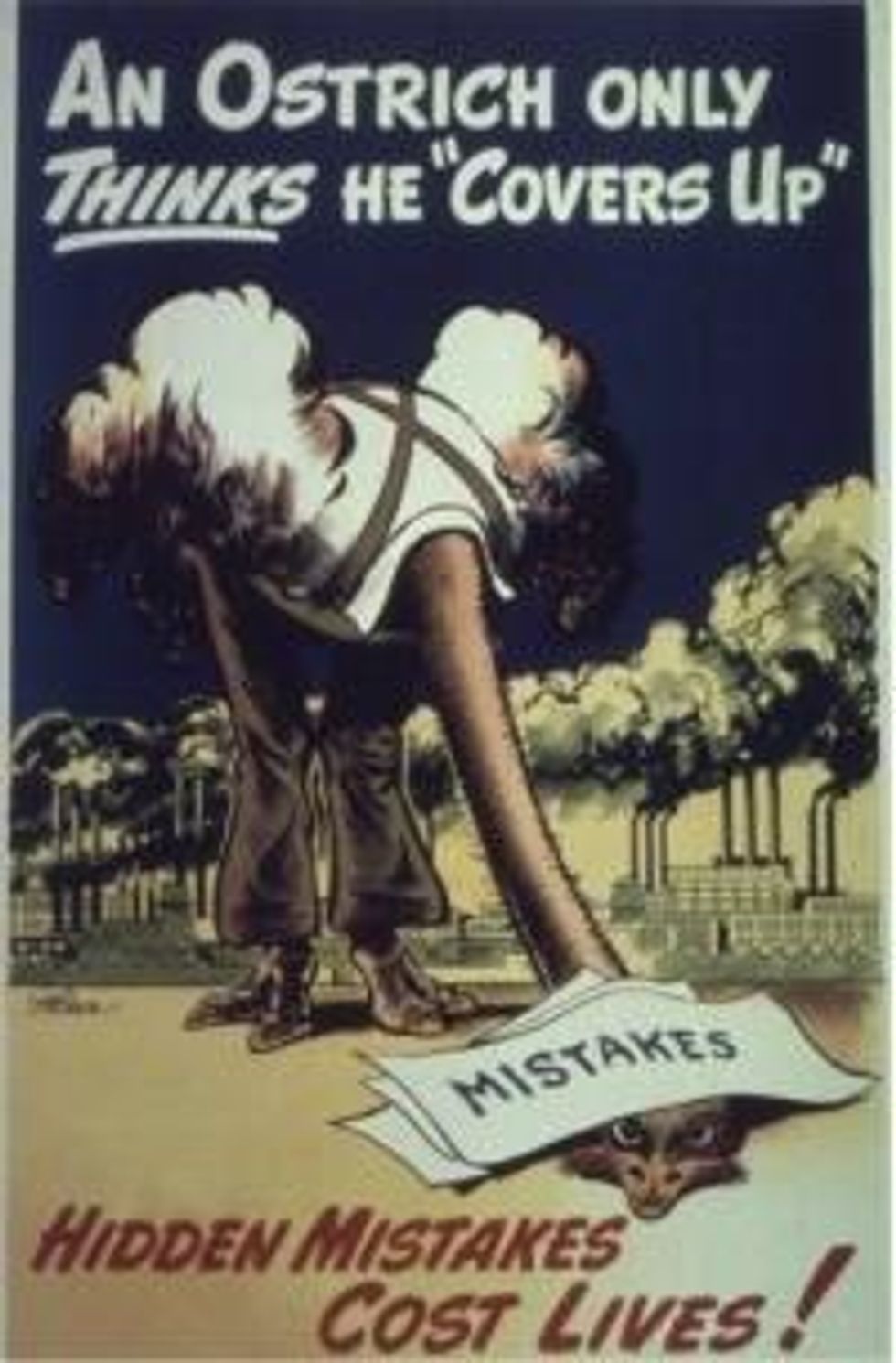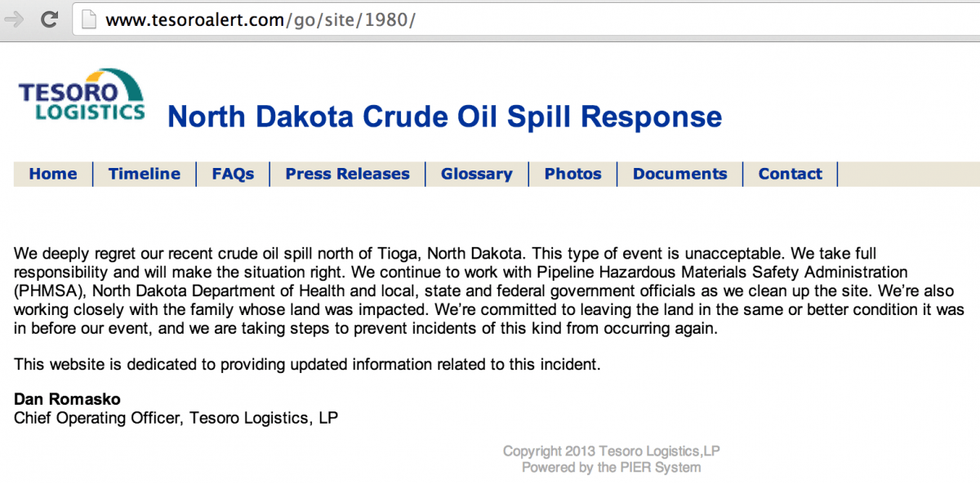

SUBSCRIBE TO OUR FREE NEWSLETTER
Daily news & progressive opinion—funded by the people, not the corporations—delivered straight to your inbox.
5
#000000
#FFFFFF
To donate by check, phone, or other method, see our More Ways to Give page.


Daily news & progressive opinion—funded by the people, not the corporations—delivered straight to your inbox.
Tesoro Logistics -- the company whose pipeline spilled more than 800,000 gallons of fracked Bakken Shale oil in rural North Dakota in September -- has hired infamous contractor Witt O'Brien's to oversee its clean-up of the biggest fracked oil spill in U.S. history.
Tesoro Logistics -- the company whose pipeline spilled more than 800,000 gallons of fracked Bakken Shale oil in rural North Dakota in September -- has hired infamous contractor Witt O'Brien's to oversee its clean-up of the biggest fracked oil spill in U.S. history.

The oil was obtained via hydraulic fracturing ("fracking") in the Bakken Shale basin.
As revealed after ExxonMobil hired the same firm in the aftermath of a 210,000-gallon tar sands oil spill in April 2013, Witt O'Brien's -- formerly known as OOPS, Inc. -- is a firm with a history of oil spill cover-ups dating back to the Exxon Valdez oil spill. It also oversaw the spraying of toxic oil dispersants into the Gulf of Mexico during BP's summer 2010 mega-spill and a literal cover-up of Enbridge's massive "dilbit disaster" tar sands pipeline spill in Michigan.
Witt O'Brien's also won a $300,000 contract to develop an emergency response plan for TransCanada's Keystone XL tar sands export pipeline in August 2008.
The same firm is now maintaining Tesoro's website dedicated to offering updates -- also known as crisis communications management -- for the massive spill's recovery efforts at TesoroAlert.com.
Buried at the bottom of the website is a mention that the site is "powered by the PIER System." PIER -- short for "Public Information Emergency Response" -- is owned by Witt O'Brien's.

A glance at PIER's website suggests it is much more focused on image clean-up than it is on actually cleaning up oil spills.
"We believe that responding effectively and communicating your efforts are two sides of the same coin," explains Witt O'Brien's website. "And since others will be telling your story, from the professional media to citizen reporters with camera phones, you must be prepared and ready to respond."
"PIER(tm) (Public Information Emergency Response) provides flexible solutions for handling internal and external communications, making it easier to deliver messages, streamline processes, automate tasks, and prevent inaccuracy during routine events, minor incidents, and major catastrophes."
Brad Johnson, at the time a writer for Think Progress, explained BP used PIER for "media and public information management" during the 2010 Gulf oil spill disaster.
In a November 1 DeSmogBlog article covering the North Dakota fracked oil spill, Kris Roberts, environmental response team leader for the North Dakota Department of Health's Division of Water Quality, said his department would be "putting [the oil] to bed for the winter" in an interview.
"We'll continue to recover any free oil, but essentially because winter is days away if not already there, they're basically just putting it back to bed, ensuring it's properly contained and monitored," Roberts said.
"They will hopefully get some natural remediation over the winter below the frost zone when the indigenous bacteria start flourishing, that'll probably help a little bit cleaning up. But for the most part, everything is pretty much on hold and active remediation is going to be on hold until next spring."
In the midwest, winter has arrived. The question remains: will the massive amount of snow allow for a literal and figurative whitewash by Tesoro -- working with Witt O'Brien's -- of the largest fracked oil spill in U.S. history?
_______________________
Dear Common Dreams reader, The U.S. is on a fast track to authoritarianism like nothing I've ever seen. Meanwhile, corporate news outlets are utterly capitulating to Trump, twisting their coverage to avoid drawing his ire while lining up to stuff cash in his pockets. That's why I believe that Common Dreams is doing the best and most consequential reporting that we've ever done. Our small but mighty team is a progressive reporting powerhouse, covering the news every day that the corporate media never will. Our mission has always been simple: To inform. To inspire. And to ignite change for the common good. Now here's the key piece that I want all our readers to understand: None of this would be possible without your financial support. That's not just some fundraising cliche. It's the absolute and literal truth. We don't accept corporate advertising and never will. We don't have a paywall because we don't think people should be blocked from critical news based on their ability to pay. Everything we do is funded by the donations of readers like you. Will you donate now to help power the nonprofit, independent reporting of Common Dreams? Thank you for being a vital member of our community. Together, we can keep independent journalism alive when it’s needed most. - Craig Brown, Co-founder |
Tesoro Logistics -- the company whose pipeline spilled more than 800,000 gallons of fracked Bakken Shale oil in rural North Dakota in September -- has hired infamous contractor Witt O'Brien's to oversee its clean-up of the biggest fracked oil spill in U.S. history.

The oil was obtained via hydraulic fracturing ("fracking") in the Bakken Shale basin.
As revealed after ExxonMobil hired the same firm in the aftermath of a 210,000-gallon tar sands oil spill in April 2013, Witt O'Brien's -- formerly known as OOPS, Inc. -- is a firm with a history of oil spill cover-ups dating back to the Exxon Valdez oil spill. It also oversaw the spraying of toxic oil dispersants into the Gulf of Mexico during BP's summer 2010 mega-spill and a literal cover-up of Enbridge's massive "dilbit disaster" tar sands pipeline spill in Michigan.
Witt O'Brien's also won a $300,000 contract to develop an emergency response plan for TransCanada's Keystone XL tar sands export pipeline in August 2008.
The same firm is now maintaining Tesoro's website dedicated to offering updates -- also known as crisis communications management -- for the massive spill's recovery efforts at TesoroAlert.com.
Buried at the bottom of the website is a mention that the site is "powered by the PIER System." PIER -- short for "Public Information Emergency Response" -- is owned by Witt O'Brien's.

A glance at PIER's website suggests it is much more focused on image clean-up than it is on actually cleaning up oil spills.
"We believe that responding effectively and communicating your efforts are two sides of the same coin," explains Witt O'Brien's website. "And since others will be telling your story, from the professional media to citizen reporters with camera phones, you must be prepared and ready to respond."
"PIER(tm) (Public Information Emergency Response) provides flexible solutions for handling internal and external communications, making it easier to deliver messages, streamline processes, automate tasks, and prevent inaccuracy during routine events, minor incidents, and major catastrophes."
Brad Johnson, at the time a writer for Think Progress, explained BP used PIER for "media and public information management" during the 2010 Gulf oil spill disaster.
In a November 1 DeSmogBlog article covering the North Dakota fracked oil spill, Kris Roberts, environmental response team leader for the North Dakota Department of Health's Division of Water Quality, said his department would be "putting [the oil] to bed for the winter" in an interview.
"We'll continue to recover any free oil, but essentially because winter is days away if not already there, they're basically just putting it back to bed, ensuring it's properly contained and monitored," Roberts said.
"They will hopefully get some natural remediation over the winter below the frost zone when the indigenous bacteria start flourishing, that'll probably help a little bit cleaning up. But for the most part, everything is pretty much on hold and active remediation is going to be on hold until next spring."
In the midwest, winter has arrived. The question remains: will the massive amount of snow allow for a literal and figurative whitewash by Tesoro -- working with Witt O'Brien's -- of the largest fracked oil spill in U.S. history?
_______________________
Tesoro Logistics -- the company whose pipeline spilled more than 800,000 gallons of fracked Bakken Shale oil in rural North Dakota in September -- has hired infamous contractor Witt O'Brien's to oversee its clean-up of the biggest fracked oil spill in U.S. history.

The oil was obtained via hydraulic fracturing ("fracking") in the Bakken Shale basin.
As revealed after ExxonMobil hired the same firm in the aftermath of a 210,000-gallon tar sands oil spill in April 2013, Witt O'Brien's -- formerly known as OOPS, Inc. -- is a firm with a history of oil spill cover-ups dating back to the Exxon Valdez oil spill. It also oversaw the spraying of toxic oil dispersants into the Gulf of Mexico during BP's summer 2010 mega-spill and a literal cover-up of Enbridge's massive "dilbit disaster" tar sands pipeline spill in Michigan.
Witt O'Brien's also won a $300,000 contract to develop an emergency response plan for TransCanada's Keystone XL tar sands export pipeline in August 2008.
The same firm is now maintaining Tesoro's website dedicated to offering updates -- also known as crisis communications management -- for the massive spill's recovery efforts at TesoroAlert.com.
Buried at the bottom of the website is a mention that the site is "powered by the PIER System." PIER -- short for "Public Information Emergency Response" -- is owned by Witt O'Brien's.

A glance at PIER's website suggests it is much more focused on image clean-up than it is on actually cleaning up oil spills.
"We believe that responding effectively and communicating your efforts are two sides of the same coin," explains Witt O'Brien's website. "And since others will be telling your story, from the professional media to citizen reporters with camera phones, you must be prepared and ready to respond."
"PIER(tm) (Public Information Emergency Response) provides flexible solutions for handling internal and external communications, making it easier to deliver messages, streamline processes, automate tasks, and prevent inaccuracy during routine events, minor incidents, and major catastrophes."
Brad Johnson, at the time a writer for Think Progress, explained BP used PIER for "media and public information management" during the 2010 Gulf oil spill disaster.
In a November 1 DeSmogBlog article covering the North Dakota fracked oil spill, Kris Roberts, environmental response team leader for the North Dakota Department of Health's Division of Water Quality, said his department would be "putting [the oil] to bed for the winter" in an interview.
"We'll continue to recover any free oil, but essentially because winter is days away if not already there, they're basically just putting it back to bed, ensuring it's properly contained and monitored," Roberts said.
"They will hopefully get some natural remediation over the winter below the frost zone when the indigenous bacteria start flourishing, that'll probably help a little bit cleaning up. But for the most part, everything is pretty much on hold and active remediation is going to be on hold until next spring."
In the midwest, winter has arrived. The question remains: will the massive amount of snow allow for a literal and figurative whitewash by Tesoro -- working with Witt O'Brien's -- of the largest fracked oil spill in U.S. history?
_______________________